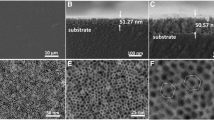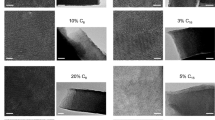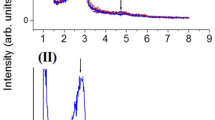Abstract
Mesoporous thin films (MTFs) displaying high surface area and controlled porosity constitute interesting materials for a plethora of applications in optics and electronics. A critical aspect in MTF processing is template removal that usually consists in thermal treatment at 350 °C, which consolidates the oxide film but might change the pore features. In addition, the use of such high temperature must be avoided when organic functionalities are to be preserved, or in the case of film deposition on polymeric substrates. Here we present and compare five different methods to consolidate silica MTF (SMTF) in mild conditions, at a maximum processing temperature of 130 °C. Conditions, such as duration of the thermal treatment, vacuum conditions, exposure to acidic and alkaline media, were systematically explored and the resulting films were analyzed by optical microscopy, focused ion beam, scanning electron microscopy, ellipsometry, and infrared spectroscopy. The optimized conditions leading to accessible mesopores and a stable oxide structure that can be used as a mesoporous perm-selective electrode are discussed.

Highlights
-
Soft template extraction methods from mesoporous silica thin films onto Si and Au were compared.
-
These low-T treatments permit to extract ionic and non-ionic surfactants, keeping film integrity.
-
A complete analysis on template extraction, film adhesion, and mesopore size is provided.
-
Optimized 130 °C treatment followed by vacuum leads to robust frameworks with accessible mesopores.
-
Mesoporous electrodes can be used for more than 90 consecutive electrochemical cycles in aqueous solutions.






Similar content being viewed by others

References
Serrano E, Linares N, Garcia-Martinez J, Berenguer JR (2013) Sol-gel coordination chemistry: building catalysts from the bottom-up. ChemCatChem 5:844–860. https://doi.org/10.1002/cctc.201200938
Brinker CJ, Lu Y, Sellinger A, Fan H (1999) Evaporation-induced self-assembly: nanostructures made easy. Adv Mater 11:579–585. https://doi.org/10.1002/(SICI)1521-4095(199905)11:7<579::AID-ADMA579>3.0.CO;2-R3.0.CO;2
Wang J, Ma Q, Wang Y et al. (2018) New insights into the structure-performance relationships of mesoporous materials in analytical science. Chem Soc Rev 47:8766–8803. https://doi.org/10.1039/c8cs00658j
Wei J, Sun Z, Luo W et al. (2017) New insight into the synthesis of large-pore ordered mesoporous materials. J Am Chem Soc 139:1706–1713. https://doi.org/10.1021/jacs.6b11411
Florek J, Caillard R, Kleitz F (2017) Evaluation of mesoporous silica nanoparticles for oral drug delivery-current status and perspective of MSNs drug carriers. Nanoscale 9:15252–15277. https://doi.org/10.1039/c7nr05762h
Walcarius A (2018) Silica-based electrochemical sensors and biosensors: recent trends. Curr Opin Electrochem 10:88–97. https://doi.org/10.1016/j.coelec.2018.03.017
Innocenzi P, Malfatti L (2013) Mesoporous thin films: properties and applications. Chem Soc Rev 42:4198–4216. https://doi.org/10.1039/c3cs35377j
Laskowski Ł, Laskowska M, Vila N et al. (2019) Mesoporous silica-based materials for electronics-oriented applications. Molecules 24:2395. https://doi.org/10.3390/molecules24132395
Etienne M, Zhang L, Vilà N, Walcarius A (2015) Mesoporous materials-based electrochemical enzymatic biosensors. Electroanalysis 27:2028–2054. https://doi.org/10.1002/elan.201500172
Vilà N, Walcarius A (2015) Electrochemical response of vertically-aligned, ferrocene-functionalized mesoporous silica films: effect of the supporting electrolyte. Electrochim Acta. https://doi.org/10.1016/j.electacta.2015.02.169
Grosso D, Balkenende AR, Albouy PA et al. (2001) Two-dimensional hexagonal mesoporous silica thin films prepared from block copolymers: detailed characterization and formation mechanism. Chem Mater 13:1848–1856. https://doi.org/10.1021/cm001225b
Herregods SJF, Mertens M, Van Havenbergh K et al. (2013) Controlling pore size and uniformity of mesoporous titania by early stage low temperature stabilization. J Colloid Interface Sci 391:36–44. https://doi.org/10.1016/j.jcis.2012.07.098
Beck JS, Vartuli JC, Roth WJ et al. (1992) A new family of mesoporous molecular sieves prepared with liquid crystal templates. J Am Chem Soc 10834–10843. https://doi.org/10.1021/ja00053a020
Kresge CT, Leonowicz ME, Roth WJ et al. (1992) Ordered mesoporous molecular sieves synthesized by a liquid-crystal template mechanism. Nature 359:710–712. https://doi.org/10.1038/359710a0
Di Renzo F, Cambon H, Dutartre R (1997) A 28-year-old synthesis of micelle-templated mesoporous silica. Microporous Mater 10:283–286. https://doi.org/10.1016/S0927-6513(97)00028-X
Clark T, Ruiz JD, Fan H et al. (2000) A new application of UV-ozone treatment the preparation of substrate-supported, mesoporous thin films. Chem Mater 12:3879–3884. https://doi.org/10.1021/cm000456f
Hozumi A, Yokogawa Y, Kameyama T et al. (2000) Photocalcination of mesoporous silica films using vacuum ultraviolet light. Adv Mater 12:985–987. https://doi.org/10.1002/1521-4095(200006)12:13<985::AID-ADMA985>3.0.CO;2-#
Huang J, Ichinose I, Kunitake T, Nakao A (2002) Preparation of nanoporous Titania films by surface sol-gel process accompanied by low-temperature oxygen plasma treatment. Langmuir 18:9048–9053. https://doi.org/10.1021/la026091q
Zhang J, Palaniappan A, Su X, Tay FEH (2005) Mesoporous silica thin films prepared by argon plasma treatment of sol–gel-derived precursor. Appl Surf Sci 245:304–309. https://doi.org/10.1016/j.apsusc.2004.10.049
Horiuchi Y, Ura H, Kamegawa T et al. (2011) Low-temperature synthesis of highly hydrophilic Ti-containing mesoporous silica thin films on polymer substrates by photocatalytic removal of structure-directing agents. J Mater Chem 21:236. https://doi.org/10.1039/c0jm01404d
Soler-Illia GJAA, Crepaldi EL, Grosso D et al. (2002) Structural control in self-standing mesostructured silica oriented membranes and xerogels. Chem Commun 2298–2299
Cagnol F, Grosso D, Soler-Illia GJAA (2003) Humidity-controlled mesostructuration in CTAB-templated silica thin film processing. The existence of amodulable steady state. J Mater Chem 13:61–66
Brinker CJ, Scherer GW (1990) Sol-gel science: the physics and chemistry of sol-gel processing. Academic Press, London
Nasir T, Zhang L, Vilà N, et al. (2016) Electrografting of 3-aminopropyltriethoxysilane on a glassy carbon electrode for the improved adhesion of vertically oriented mesoporous silica thin films. Langmuir 32. https://doi.org/10.1021/acs.langmuir.6b00798
Soler-Illia GJAA, Innocenzi P (2006) Mesoporous hybrid thin films: the physics and chemistry beneath. Chemistry 12:4478–4494
Grosso D, Cagnol F, Soler-Illia GJDAA. et al. (2004) Fundamentals of mesostructuring through evaporation-induced self-assembly. Adv Funct Mater 14. https://doi.org/10.1002/adfm.200305036
Soler-Illia GJAA, Angelomé PC, Fuertes MC. et al. (2011) Mesoporous hybrid and nanocomposite thin films. A sol-gel toolbox to create nanoconfined systems with localized chemical properties. J Sol-Gel Sci Technol 57:299–312. https://doi.org/10.1007/s10971-010-2172-2
Soler-Illia GJDAA, Sanchez C, Lebeau B, Patarin J (2002) Chemical strategies to design textured materials: from microporous and mesoporous oxides to nanonetworks and hierarchical structures. Chem Rev 102. https://doi.org/10.1021/cr0200062
Crepaldi EL, Soler-Illia GJDAA, Grosso D, Sanchez C (2003) Nanocrystallised titania and zirconia mesoporous thin films exhibiting enhanced thermal stability. New J Chem 27. https://doi.org/10.1039/b205497n
Crepaldi EL, Soler-Illia GJDAA, Grosso D. et al. (2003) Controlled formation of highly organized mesoporous titania thin films: from mesostructured hybrids to mesoporous nanoanatase TiO2. J Am Chem Soc 125. https://doi.org/10.1021/ja030070g
Soler-Illia GJAA, Angelomé PC, Fuertes MC et al. (2012) Critical aspects in the production of periodically ordered mesoporous titania thin films. Nanoscale 4:2549–2566. https://doi.org/10.1039/c2nr11817c
Zhuravlev LT (2000) The surface chemistry of amorphous silica. Zhuravlev model. Colloids Surf A 173:1–38. https://doi.org/10.1016/S0927-7757(00)00556-2
Mogilnikov KP, Baklanov MR (2002) Determination of Young’s modulus of porous low-k films by ellipsometric porosimetry. Electrochem Solid-State Lett 5:F29. https://doi.org/10.1149/1.1517771
Fuertes MC, Colodrero S, Lozano G et al. (2008) Sorption properties of mesoporous multilayer thin films. J Phys Chem C 112:3157–3163. https://doi.org/10.1021/jp710612y
Doshi DA, Huesing NK, Lu M et al. (2000) Optically defined multifunctional patterning of photosensitive thin-film silica mesophases. Science 290:107–111. https://doi.org/10.1126/science.290.5489.107
Soler-Illia GJAA, Azzaroni O (2011) Multifunctional hybrids by combining ordered mesoporous materials and macromolecular building blocks. Chem Soc Rev 40. https://doi.org/10.1039/c0cs00208a
Huo Q, Margolese DI, Stucky GD (1996) Surfactant control of phases in the synthesis of mesoporous silica-based materials. Chem Mater 8:1147–1160. https://doi.org/10.1021/cm960137h
Boissiere C, Larbot A, Prouzet E (2000) Synthesis of mesoporous MSU-X materials using. Chem Mater 12:1937–1940. https://doi.org/10.1021/cm001012m
Gonzalez Solveyra E, Fuertes MC, Soler-Illia GJAA, Angelomé PC (2017) 2D-SAXS in situ measurements as a tool to study elusive mesoporous phases: the case of p6mm TiO2. J Phys Chem C 121:3623–3631. https://doi.org/10.1021/acs.jpcc.6b12112
Ichinose I, Kunitake T (2002) Wrapping and inclusion of organic molecules with ultrathin, amorphous metal oxide films. Chem Rec 2:339–351. https://doi.org/10.1002/tcr.10032
Fischereder A, Martínez-Ricci M, Wolosiuk A et al. Mesoporous ZnS thin films prepared by a nanocasting route. Chem Mater 24:1837–1845. https://doi.org/10.1021/cm300395m
Tompkins HG, McGahan WA (1999) Spectroscopic ellipsometry and reflectometry. A user’s guide, 1st edn. Wiley-Interscience, New York
Boissiere C, Grosso D, Lepoutre S et al. (2005) Porosity and mechanical properties of mesoporous thin films assessed by environmental ellipsometric porosimetry. Langmuir 21:12362–12371. https://doi.org/10.1021/la050981z
Fattakhova-Rohlfing D (2007) Ion-permselective pH-switchable mesoporous silica thin layers. Chem Mater 19:1640–1647. https://doi.org/10.1021/cm062389g
Calvo A, Fuertes MC, Yameen B et al. (2010) Nanochemistry in confined environments: polyelectrolyte brush-assisted synthesis of gold nanoparticles inside ordered mesoporous thin films. Langmuir 26:5559–5567. https://doi.org/10.1021/la9038304
Malfatti L, Bellino MG, Innocenzi P, Soler-Illia GJAA (2009) One-pot route to produce hierarchically porous titania thin films by controlled self-assembly, swelling, and phase separation. Chem Mater 21:2763–2769
Thommes M, Kaneko K, Neimark AV et al. (2015) Physisorption of gases, with special reference to the evaluation of surface area and pore size distribution (IUPAC Technical Report). Pure Appl Chem 87:1051–1069. https://doi.org/10.1515/pac-2014-1117
Etienne M, Quach A, Grosso D et al. (2007) Molecular transport into mesostructured silica thin films: electrochemical monitoring and comparison between p6m, P63/mmc, and Pm3n structures. Chem Mater 19:844–856. https://doi.org/10.1021/cm0625068
Thielemann J, Girgsdies F, Schlögl R, Hess C (2011) Pore structure and surface area of silica SBA-15: influence of washing and scale-up. Beilstein J Nanotechnol 2:110–8. https://doi.org/10.3762/bjnano.2.13
Groen JC, Peffer LAA, Pérez-Ramírez J (2003) Pore size determination in modified micro- and mesoporous materials. Pitfalls and limitations in gas adsorption data analysis. Microporous Mesoporous Mater 60:1–17. https://doi.org/10.1016/S1387-1811(03)00339-1
Gregg SJ, Sing KSW, Salzberg HW (1967) Adsorption surface area and porosity. J Electrochem Soc 114:279C. https://doi.org/10.1149/1.2426447
Soler-Illia GJAA, Crepaldi EL, Grosso D et al. (2002) Structural control in self-standing mesostructured silica oriented membranes and xerogels. Chem Commun 20:2298–2299. https://doi.org/10.1039/B207595D
Angelomé PC (2008) Films delgados mesoporosos de óxidos metálicos, mixtos e híbridos. Hacia un diseño racional de nanomaterialesfuncionales. Facultad de Ciencias Exactas y Naturales—UBA, Buenos Aires
Innocenzi P (2003) Infrared spectroscopy of sol–gel derived silica-based films: a spectra-microstructure overview. J Non-Cryst Solids 316:309–319. https://doi.org/10.1016/S0022-3093(02)01637-X
Olsen JE, Shimura F (1989) Infrared reflection spectroscopy of the SiO2-silicon interface. J Appl Phys 66:1353–1358. https://doi.org/10.1063/1.344435
Alberti S, Steinberg PY, Giménez G et al. (2019) Chemical stability of mesoporous oxide thin film electrodes under electrochemical cycling: from dissolution to stabilization. Langmuir 35:6279–6287. https://doi.org/10.1021/acs.langmuir.9b00224
Mazer J, Walther J (1994) Dissolution kinetics of silica glass as a function of pH between 40 and 85 °C. J Non-Cryst Solids 170:32–45. https://doi.org/10.1016/0022-3093(94)90100-7
Niibori Y, Kunita M, Tochiyama O, Chida T (2000) Dissolution rates of amorphous silica in highly alkaline solution. J Nucl Sci Technol 37:349–357. https://doi.org/10.1080/18811248.2000.9714905
Gorrepati EA, Wongthahan P, Raha S, Fogler HS (2010) Silica precipitation in acidic solutions: mechanism, pH effect, and salt effect. Langmuir 26:10467–10474. https://doi.org/10.1021/la904685x
Lange P, Schnakenberg U, Ullerich S, Schliwinski HJ (1990) Disorder in vitreous SiO2: the effect of thermal annealing on structural properties. J Appl Phys 68:3532–3537. https://doi.org/10.1063/1.346312
Lange P, Windbracke W (1989) Characterization of thermal and deposited thin oxide layers by longitudinal optical-transverse optical excitation in fourier transform IR transmission measurements. Thin Solid Films 174:159–164. https://doi.org/10.1016/0040-6090(89)90885-7
Lange P (1989) Evidence for disorder-induced vibrational mode coupling in thin amorphous SiO2 films. J Appl Phys 66:201–204. https://doi.org/10.1063/1.344472
Shimizu W, Murakami Y (2010) Microporous silica thin films with low refractive indices and high Young’s modulus. ACS Appl Mater Interfaces 2:3128–3133. https://doi.org/10.1021/am100612g
Gazoni RM, Bellino MG, Cecilia Fuertes M et al. (2017) Designed nanoparticle–mesoporous multilayer nanocomposites as tunable plasmonic–photonicarchitectures for electromagnetic field enhancement. J Mater Chem C. https://doi.org/10.1039/C6TC05195B
Robertson C, Lodge AW, Basa P et al. (2016) Surface modification and porosimetry of vertically aligned hexagonal mesoporous silica films. RSC Adv 6:113432–113441. https://doi.org/10.1039/C6RA23059H
Fuertes MC (2009) Materiales funcionales multiescala basados en películas de óxidos mesoporosos. UNSAM, San Martín
Brinker CJ, Lu Y, Ganguli R et al. (1997) Continuous formation of supported cubic and hexagonal mesoporous films by sol–gel dip-coating. Nature 389:364–368. https://doi.org/10.1038/38699
Cheng W, Dong S, Wang E (2003) Synthesis and self-assembly of cetyltrimethylammonium bromide-capped gold nanoparticles. Langmuir 19:9434–9439. https://doi.org/10.1021/la034818k
Smith DK, Korgel BA (2008) The importance of the CTAB surfactant on the colloidal seed-mediated synthesis of gold nanorods. Langmuir 24:644–649. https://doi.org/10.1021/la703625a
Acknowledgements
This work was supported by INTI, INS-UNSAM, and Agencia Nacional de Promoción Científica y Tecnológica (Projects PICT-2015-3526, PICT 2017-4651, and PICT-2018-04236). Dr. M.C. Fuertes is gratefully thanked for the EPAs measurements.
Author information
Authors and Affiliations
Corresponding author
Ethics declarations
Conflict of interest
The authors declare that they have no conflict of interest.
Additional information
Publisher’s note Springer Nature remains neutral with regard to jurisdictional claims in published maps and institutional affiliations.
Supplementary information
Rights and permissions
About this article
Cite this article
Giménez, G., Ybarra, G. & Soler-Illia, G.J.A.A. Preparation of mesoporous silica thin films at low temperature: a comparison of mild structure consolidation and template extraction procedures. J Sol-Gel Sci Technol 96, 287–296 (2020). https://doi.org/10.1007/s10971-020-05410-z
Received:
Accepted:
Published:
Issue Date:
DOI: https://doi.org/10.1007/s10971-020-05410-z



